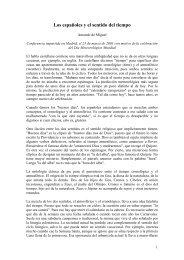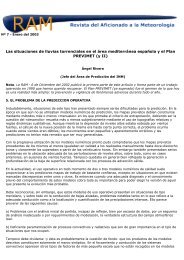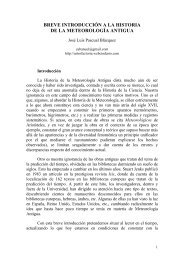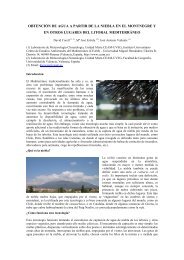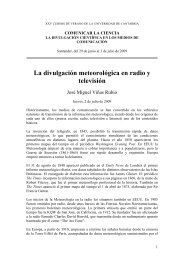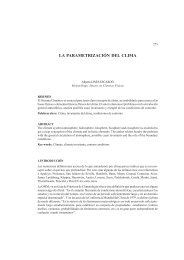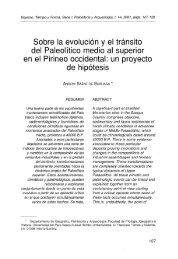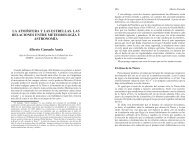BibliografíaStumpf, G.J., T.M. Smith y J. Hocker, 2004: New Hail Diagnostic Parameters Dervied byIntegrating Multiple Radars and Multiple Sensors. Preprints, 22nd Conf. on SevereLocal Storms, Hyannis, MA, Amer. Meteor. Soc., P7.8 - CD preprints.Suomi, V.E., R. Fox, S.S. Limaye y W.L. Smith, 1983: McIDAS III: A Modern Interactive DataAccess and Analysis System. J. Appl. Meteor., 22, 5, 766–778.T, U, VThe TORnado and storm Research Organisation. http://www.torro.org.uk.Th<strong>el</strong>wis, J., 1961: Encyclopedic dictionary of physics. Pergamon Press.Towery, N.J. y A.S.Changnon Jr., 1974: A review of surface hail sensors. Journal of WeatherModification, 6, 1, 304-317.Tudurí, E., y C.Ramis, 1997: On the environments of significant convective events in thewestern Mediterranean. Wea. Forecasting, 12, 294–306.Tukey, J. W., 1977: Exploratory Data Analysis: Addison-Wesley, Reading, Mass., 688 pp.UCAR communications, 2003: One hail of a storm. Staff notes monthly, July/August.V<strong>el</strong>leman, P.F. y Hoaglin, D.C., 1981: Applications, Basics, and Computing of ExploratoryData Analysis: Duxbury Press, Boston, 354 pp.Vento, D., 1976: The hailpad calibration for Italian hail damage documentation. J. Appl.Meteor., 15, 1018-1022.Vila, D.A. y L.A.T. Machado, 2004: Shape and radiative properties of convective systemsobserved from infrared sat<strong>el</strong>lite images. Int. J. Remote Sensing, 25, 21, 4441-4456.Vivekanandan, J., D.S. Zrnić, S.M. Ellis, R. Oye, A.V. Ryzhkov y J. Straka, 1999: Cloudmicrophysics retrieval using S-band dual-polarization <strong>radar</strong> measurements. Bull. Amer.Meteor. Soc., 80, 3, 381-388.W, Y, ZWagenmaker, R.B., 1992: Operational detection of hail by <strong>radar</strong> using heights of VIP-5reflectivity echoes. Natl. Wea. Dig., 17 (2), 2–15.Wakimoto, R.M. y N.T. Atkins, 1994: Observations of the sea-breeze front during CaPE. Part I:Single-Doppler, sat<strong>el</strong>lite, and cloud photogrammetric analysis. Mon. Wea. Rev., 122,1092–1114.Wakimoto, R.M., W.-C. Lee, H.B. Bluestein, C.-H. Liu y P.H. Hildebrand, 1996: ELDORAobservations during VORTEX 95. Bull. Amer. Meteor. Soc., 77, 1465–1481.Waldvog<strong>el</strong>, A., B. Federer y P. Grimm, 1979: Criteria for the detection of hail. J. Appl. Meteor.,16, 1521-1525.Waldvog<strong>el</strong>, A., B. Federer, W. Schmid y J.F. Mezeix: 1978b: The kinetic energy of hailfalls.Part II. Radar and hailpads. J. Appl. Meteorol. 17, 11, 1680-1693.Waldvog<strong>el</strong>, A., L. Klein, D. J. Musil y P.L. Smith, 1987: Characteristics of <strong>radar</strong>-identified bigdrop zones in Swiss hailstorms. J. Climate Appl. Meteor., 26, 861–877.218
<strong>Identificación</strong> y <strong>caracterización</strong> <strong>d<strong>el</strong></strong> <strong>granizo</strong>. Predicción de las células convectivasWaldvog<strong>el</strong>, A., W. Schmid y B. Federer, 1978a: The kinetic energy of hailfalls. Part I. Hailstonespectra. J. Appl. Meteorol. 17, 4, 515-520.Walko, R.L., W.R. Cotton, M.P. Meyers y J.L. Harrington, 1995: New RAMS cloudmicrophysics parametrization: Part I. The single-moment scheme. Atmos. Res. 38, 29–62.Warner, J. y S. Twomey, 1956: The use of silver iodide for seeding individual clouds. T<strong>el</strong>lus, 8,453-457.Warner, J., 1970. On steady-state one-dimensional mo<strong>d<strong>el</strong></strong>s of cumulus convection. J. Atmos.Sci., 27, 1035–1040.Webb, J.D.C., D.M. Elsom y G.T. Meaden, 1986: The TORRO hailstorm intensity scale. J.Meteorol. 11, 337–339.Weisman, M.L. y J.B. Klemp, 1986: Characteristics of Isolated Convective Storms. InMesoscale Meteorology and Forecasting. P.S. Ray (Ed.), Amer. Meteor. Soc., Boston,331-358.Westrick, K.J., C.F. Mass y B.A. Colle, 1999: The limitations of the WSR-88D <strong>radar</strong> networkfor quantitative precipitation measurement over the coastal western United States. Bull.Amer. Meteor. Soc., 80, 2289–2298.Whiton, R.C., P.L. Smith, S.G. Bigler, K.E. Wilk y A.C. Harbuck, 1998: History of OperationalUse of Weather Radar by U.S. Weather Services. Part I: The Pre-NEXRAD Era. Wea.Forecasting, 13, 2, 219–243.Wilh<strong>el</strong>mson, R.B. y J.B. Klemp, 1981: A threedimensional numerical simulation of splittingsevere storms on 3 April 1964. J. Atmos. Sci. 38, 1581–1600.Wilks, D. S., 1995: Statistical Methods in the Atmospheric Sciences. Academic Press, 467 pp.Wilson, J.W. y W.E. Schreiber, 1986: Initiation of convective storms at <strong>radar</strong>-observedboundary-layer convergence lines. Mon. Wea. Rev., 114, 2516–2536.Wilson, J.W., E.E. Ebert, T.R. Saxen, R.D. Roberts, C.K. Mu<strong>el</strong>ler, M. Sleigh, C.E. Pierce y A.Seed, 2004: Sydney 2000 Forecast Demonstration Project: Convective StormNowcasting Weather and Forecasting, 19, 1, 131–150.Wilson, J.W., T.M. Weckwerth, J. Vivekanandan, R.M. Wakimoto y R.W. Russ<strong>el</strong>l, 1994:Boundary layer clear-air <strong>radar</strong> echoes: Origin of echoes and accuracy of derived winds.J. Atmos. Oceanic Technol., 11, 1184–1206.Witt, A., M.D. Eilts, G.J. Stumpf, J.T. Johnson, E.D. Mitch<strong>el</strong>l y K.W. Thomas, 1998: Anenhanced hail detection algorithm for the WSR-88D. Wea. Forecasting, 13, 286-303.World Meteorological Organization, 1996: Meeting of Experts to Review the Present Status ofHail Suppression. Tech. Doc. No. 764. 39pp.Young, C. B., B.R. N<strong>el</strong>son, A.A. Bradley, J.A. Smith, C.D. Peters-Lidard, A. Kruger, y M.L.Baeck, 1999: An evaluation of NEXRAD precipitation estimates in complex terrain. J.Geophys. Res., 104 (D16), 19 691–19 703.Ziegler, C.L., T.J. Lee y R.A. Pi<strong>el</strong>ke, 1997: Convective initiation at the dryline: A mo<strong>d<strong>el</strong></strong>ingstudy. Mon. Wea. Rev., 125, 1001–1026.Ziegler, C.L. y E.N. Rasmussen, 1998: The Initiation of Moist Convection at the Dryline:Forecasting Issues from aCase Study Perspective. Wea. Forecasting, 13, 4, 1106–1131.Zrnić, D.S., A.V. Ryzhkov, J. Straka, Y. Liu y J. Vivekanandan, 2001: Testing a procedure forautomatic classification of hydrometeor types. J. Atmos. Oceanic Tech., 18, 6, 892-913.219
- Page 6 and 7:
Índice4.4 Los radiosondeos .......
- Page 10 and 11:
Agradecimientos / AgraïmentsTota a
- Page 12 and 13:
Resumenobteniendo una óptima estim
- Page 14:
Abstractresults the relationships b
- Page 17 and 18:
Identificación y caracterización
- Page 19 and 20:
Identificación y caracterización
- Page 21:
Identificación y caracterización
- Page 25 and 26:
Identificación y caracterización
- Page 27 and 28:
Identificación y caracterización
- Page 29 and 30:
Identificación y caracterización
- Page 31 and 32:
Identificación y caracterización
- Page 33 and 34:
Identificación y caracterización
- Page 35 and 36:
Identificación y caracterización
- Page 37 and 38:
Identificación y caracterización
- Page 39:
Identificación y caracterización
- Page 42 and 43:
El granizoEn cuanto a su forma, el
- Page 44 and 45:
El granizo• La formación de las
- Page 46 and 47:
El granizoFigura 3.5 Vista esquemá
- Page 48 and 49:
El granizo3.5 Órdenes de magnitudL
- Page 50 and 51:
El granizo(171 km/h), en este caso
- Page 52 and 53:
El granizoFigura 3.8 Tamaño máxim
- Page 54 and 55:
El granizo• Una escala muy sofist
- Page 56 and 57:
El granizoEn resumen, existen una g
- Page 58 and 59:
El granizodistribución espacial de
- Page 60 and 61:
El granizola zona del Valle del Ebr
- Page 62 and 63:
El granizo• Una extensión de las
- Page 65 and 66:
Identificación y caracterización
- Page 67 and 68:
Identificación y caracterización
- Page 69 and 70:
Identificación y caracterización
- Page 71 and 72:
Identificación y caracterización
- Page 73 and 74:
Identificación y caracterización
- Page 75 and 76:
Identificación y caracterización
- Page 77 and 78:
Identificación y caracterización
- Page 79 and 80:
Identificación y caracterización
- Page 81 and 82:
Identificación y caracterización
- Page 83 and 84:
Identificación y caracterización
- Page 85 and 86:
Identificación y caracterización
- Page 87 and 88:
Identificación y caracterización
- Page 89 and 90:
Identificación y caracterización
- Page 91 and 92:
Identificación y caracterización
- Page 93 and 94:
Identificación y caracterización
- Page 95 and 96:
Identificación y caracterización
- Page 97 and 98:
Identificación y caracterización
- Page 99 and 100:
Identificación y caracterización
- Page 101 and 102:
Identificación y caracterización
- Page 103 and 104:
Identificación y caracterización
- Page 105 and 106:
Identificación y caracterización
- Page 107 and 108:
Identificación y caracterización
- Page 109 and 110:
Identificación y caracterización
- Page 111 and 112:
Identificación y caracterización
- Page 113:
Identificación y caracterización
- Page 116 and 117:
Las campañas de observación de gr
- Page 118 and 119:
Las campañas de observación de gr
- Page 120 and 121:
Las campañas de observación de gr
- Page 122 and 123:
Las campañas de observación de gr
- Page 124 and 125:
Las campañas de observación de gr
- Page 126 and 127:
Las campañas de observación de gr
- Page 128 and 129:
Situaciones con y sin granizo y det
- Page 130 and 131:
Situaciones con y sin granizo y det
- Page 132 and 133:
Situaciones con y sin granizo y det
- Page 134 and 135:
Situaciones con y sin granizo y det
- Page 136 and 137:
Situaciones con y sin granizo y det
- Page 138 and 139:
Situaciones con y sin granizo y det
- Page 140 and 141:
Situaciones con y sin granizo y det
- Page 142 and 143:
Situaciones con y sin granizo y det
- Page 144 and 145:
Situaciones con y sin granizo y det
- Page 146 and 147:
Situaciones con y sin granizo y det
- Page 148 and 149:
Situaciones con y sin granizo y det
- Page 150 and 151:
Situaciones con y sin granizo y det
- Page 152 and 153:
Situaciones con y sin granizo y det
- Page 154 and 155:
Situaciones con y sin granizo y det
- Page 156 and 157:
Situaciones con y sin granizo y det
- Page 158 and 159:
Situaciones con y sin granizo y det
- Page 160 and 161:
Situaciones con y sin granizo y det
- Page 162 and 163:
Situaciones con y sin granizo y det
- Page 164 and 165:
Situaciones con y sin granizo y det
- Page 166 and 167:
Situaciones con y sin granizo y det
- Page 168 and 169:
Situaciones con y sin granizo y det
- Page 170 and 171:
Situaciones con y sin granizo y det
- Page 172 and 173:
Situaciones con y sin granizo y det
- Page 174 and 175:
Situaciones con y sin granizo y det
- Page 177 and 178:
Identificación y caracterización
- Page 179 and 180:
Identificación y caracterización
- Page 181 and 182: Identificación y caracterización
- Page 183 and 184: Identificación y caracterización
- Page 185 and 186: Identificación y caracterización
- Page 187 and 188: Identificación y caracterización
- Page 189 and 190: Identificación y caracterización
- Page 191 and 192: Identificación y caracterización
- Page 193: Identificación y caracterización
- Page 196 and 197: Conclusionesexistentes se han mostr
- Page 198 and 199: Conclusioneslugar en ella sean de d
- Page 200 and 201: Conclusiones9.4 Las campañas exper
- Page 202 and 203: Conclusionesla incidencia perpendic
- Page 204 and 205: Conclusionessubjetivas, cometiendo
- Page 206 and 207: Conclusionesrelacionados con las di
- Page 208 and 209: Conclusiones9.7 La predicción de l
- Page 210 and 211: Conclusionesdetectándose variacion
- Page 212 and 213: Conclusiones• La organización de
- Page 215 and 216: Identificación y caracterización
- Page 217: Identificación y caracterización
- Page 220 and 221: BibliografíaAugustine, J.A. y K.W.
- Page 222 and 223: BibliografíaDDas, P., 1979: A non-
- Page 224 and 225: BibliografíaGGalletti, M., P.P. Al
- Page 226 and 227: BibliografíaKaňák, J., M. Benko,
- Page 228 and 229: BibliografíaMarkowski, P., 2005c:
- Page 230 and 231: BibliografíaPierce, C.E., P.J. Har
- Page 235 and 236: Identificación y caracterización
- Page 237 and 238: Identificación y caracterización
- Page 239 and 240: Identificación y caracterización
- Page 241: Identificación y caracterización
- Page 244 and 245: Índice de tablasTabla. 7.4 Diferen
- Page 246: AcrónimosMUL - Sistema Multicelula



